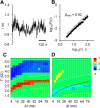Relationship of fast- and slow-timescale neuronal dynamics in human MEG and SEEG
- PMID: 25834062
- PMCID: PMC6705402
- DOI: 10.1523/JNEUROSCI.4880-14.2015
Relationship of fast- and slow-timescale neuronal dynamics in human MEG and SEEG
Abstract
A growing body of evidence suggests that the neuronal dynamics are poised at criticality. Neuronal avalanches and long-range temporal correlations (LRTCs) are hallmarks of such critical dynamics in neuronal activity and occur at fast (subsecond) and slow (seconds to hours) timescales, respectively. The critical dynamics at different timescales can be characterized by their power-law scaling exponents. However, insight into the avalanche dynamics and LRTCs in the human brain has been largely obtained with sensor-level MEG and EEG recordings, which yield only limited anatomical insight and results confounded by signal mixing. We investigated here the relationship between the human neuronal dynamics at fast and slow timescales using both source-reconstructed MEG and intracranial stereotactical electroencephalography (SEEG). Both MEG and SEEG revealed avalanche dynamics that were characterized parameter-dependently by power-law or truncated-power-law size distributions. Both methods also revealed robust LRTCs throughout the neocortex with distinct scaling exponents in different functional brain systems and frequency bands. The exponents of power-law regimen neuronal avalanches and LRTCs were strongly correlated across subjects. Qualitatively similar power-law correlations were also observed in surrogate data without spatial correlations but with scaling exponents distinct from those of original data. Furthermore, we found that LRTCs in the autonomous nervous system, as indexed by heart-rate variability, were correlated in a complex manner with cortical neuronal avalanches and LRTCs in MEG but not SEEG. These scalp and intracranial data hence show that power-law scaling behavior is a pervasive but neuroanatomically inhomogeneous property of neuronal dynamics in central and autonomous nervous systems.
Keywords: MEG; SEEG; heart-rate variability; long-range temporal correlations; neuronal avalanches; scale-free dynamics.
Copyright © 2015 the authors 0270-6474/15/355385-12$15.00/0.
Figures









Similar articles
-
Neuronal long-range temporal correlations and avalanche dynamics are correlated with behavioral scaling laws.Proc Natl Acad Sci U S A. 2013 Feb 26;110(9):3585-90. doi: 10.1073/pnas.1216855110. Epub 2013 Feb 11. Proc Natl Acad Sci U S A. 2013. PMID: 23401536 Free PMC article.
-
Neuronal avalanches in the resting MEG of the human brain.J Neurosci. 2013 Apr 17;33(16):7079-90. doi: 10.1523/JNEUROSCI.4286-12.2013. J Neurosci. 2013. PMID: 23595765 Free PMC article.
-
Self-regulated critical brain dynamics originate from high frequency-band activity in the MEG.PLoS One. 2020 Jun 11;15(6):e0233589. doi: 10.1371/journal.pone.0233589. eCollection 2020. PLoS One. 2020. PMID: 32525940 Free PMC article.
-
Multiscale Modeling of EEG/MEG Response of a Compact Cluster of Tightly Spaced Pyramidal Neocortical Neurons.2020 Aug 6. In: Makarov SN, Noetscher GM, Nummenmaa A, editors. Brain and Human Body Modeling 2020: Computational Human Models Presented at EMBC 2019 and the BRAIN Initiative® 2019 Meeting [Internet]. Cham (CH): Springer; 2021. 2020 Aug 6. In: Makarov SN, Noetscher GM, Nummenmaa A, editors. Brain and Human Body Modeling 2020: Computational Human Models Presented at EMBC 2019 and the BRAIN Initiative® 2019 Meeting [Internet]. Cham (CH): Springer; 2021. PMID: 32966011 Free Books & Documents. Review.
-
Spatiotemporal dynamics in large-scale cortical networks.Curr Opin Neurobiol. 2022 Dec;77:102627. doi: 10.1016/j.conb.2022.102627. Epub 2022 Sep 15. Curr Opin Neurobiol. 2022. PMID: 36115252 Free PMC article. Review.
Cited by
-
Rhythmicity of neuronal oscillations delineates their cortical and spectral architecture.Commun Biol. 2024 Apr 3;7(1):405. doi: 10.1038/s42003-024-06083-y. Commun Biol. 2024. PMID: 38570628 Free PMC article.
-
SEEG assistant: a 3DSlicer extension to support epilepsy surgery.BMC Bioinformatics. 2017 Feb 23;18(1):124. doi: 10.1186/s12859-017-1545-8. BMC Bioinformatics. 2017. PMID: 28231759 Free PMC article.
-
A Shift Toward Supercritical Brain Dynamics Predicts Alzheimer's Disease Progression.J Neurosci. 2025 Feb 26;45(9):e0688242024. doi: 10.1523/JNEUROSCI.0688-24.2024. J Neurosci. 2025. PMID: 40011070 Free PMC article.
-
Dynamics of Long-Range Temporal Correlations in Broadband EEG During Different Motor Execution and Imagery Tasks.Front Neurosci. 2021 May 28;15:660032. doi: 10.3389/fnins.2021.660032. eCollection 2021. Front Neurosci. 2021. PMID: 34121989 Free PMC article.
-
State-Dependent Effective Connectivity in Resting-State fMRI.Front Neural Circuits. 2021 Oct 27;15:719364. doi: 10.3389/fncir.2021.719364. eCollection 2021. Front Neural Circuits. 2021. PMID: 34776875 Free PMC article.
References
-
- Arnulfo G, Hirvonen J, Nobili L, Palva S, Palva JM. Phase and amplitude correlations in resting state activity in human Stereotactical EEG recordings. Neuroimage. 2015b doi: 10.1016/j.neuroimage.2015.02.031. doi: 10.1016/j.neuroimage.2015.02.031. Advance online publication. Retrieved Feb. 24, 2015. - DOI - DOI - PubMed
Publication types
MeSH terms
LinkOut - more resources
Full Text Sources
